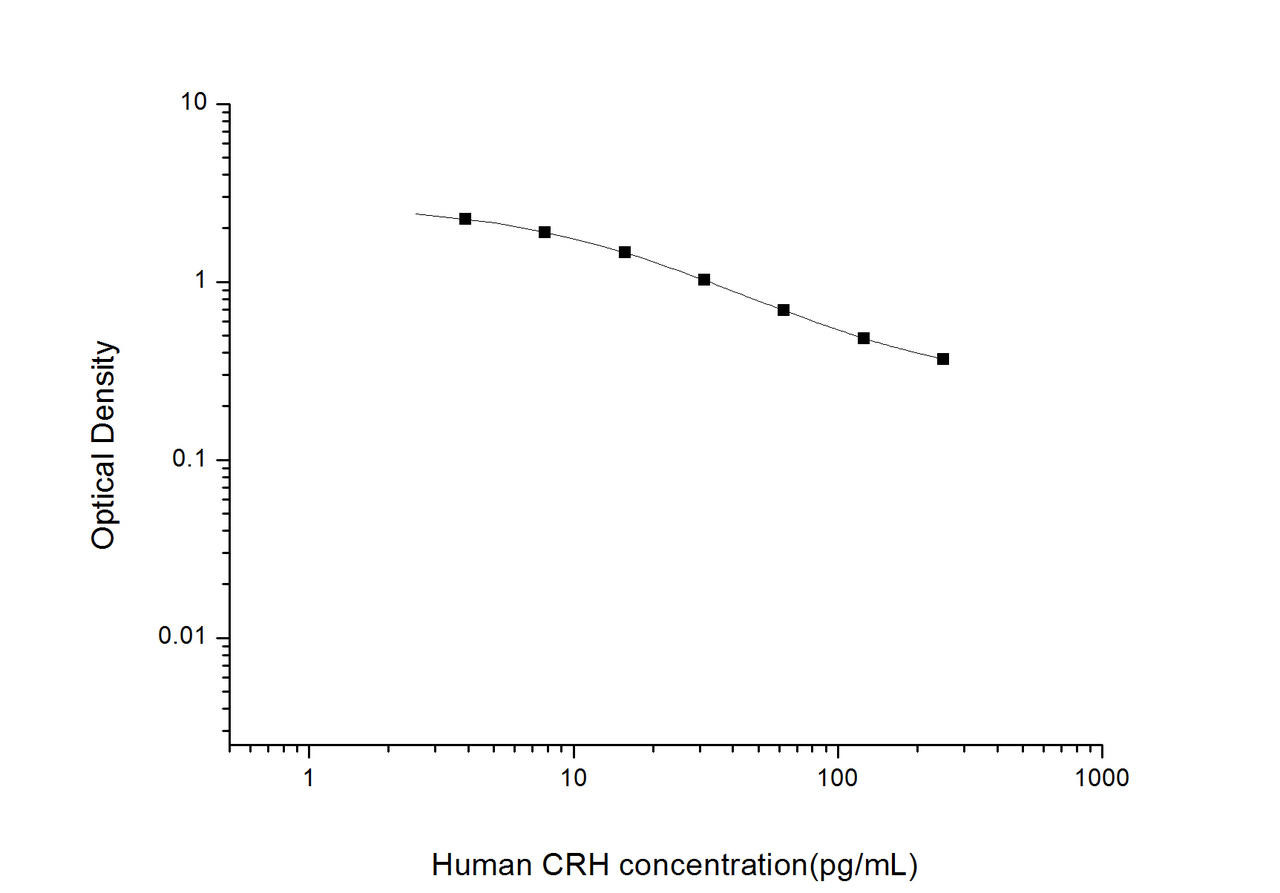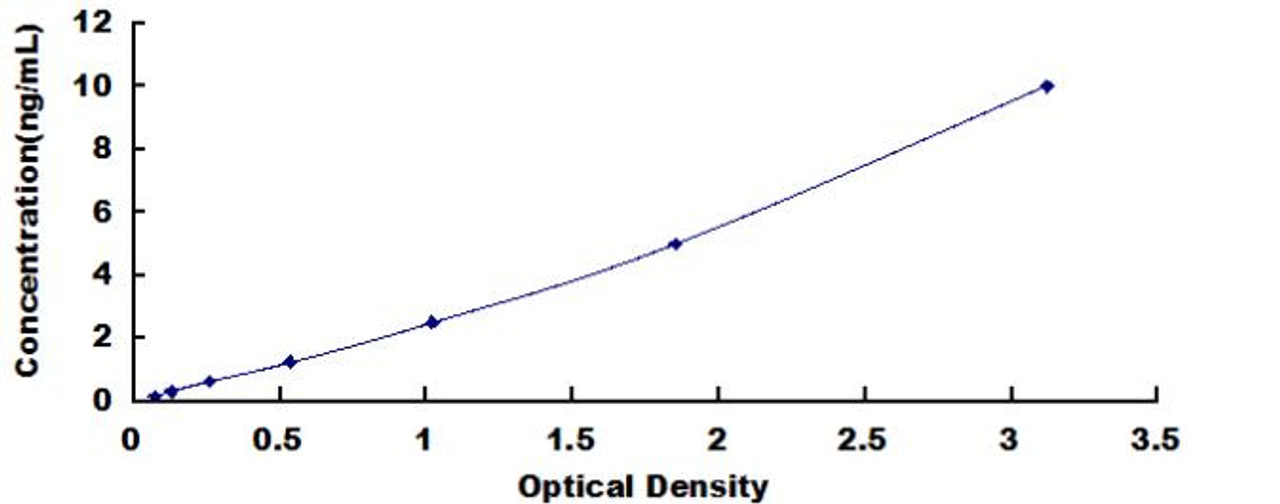Human Urocortin-2 / UCN2 ELISA Kit (HUFI01326)
- SKU:
- HUFI01326
- Product Type:
- ELISA Kit
- Size:
- 96 Assays
- Uniprot:
- Q96RP3
- Sensitivity:
- 18.75pg/ml
- Range:
- 31.25-2000pg/ml
- ELISA Type:
- Sandwich
- Synonyms:
- UCN2, Urocortin-2, Urocortin-related peptide, Stresscopin-related peptide, Urocortin II, Ucn II, SRP, URP, UII, U-II
- Reactivity:
- Human
- Research Area:
- Cell Biology
Description
Human Urocortin-2 / UCN2 ELISA Kit
Urocortin-2/UCN2 is an endogenous ligand for CRF type 2 receptors and is responsible for the effects of stress on appetite in the brain. Anxiety and cardiovascular diseases have been linked to UCN2. Presynaptic function of Kainate receptors and Signaling by GPCR are two Urocortin-2/UCN2 related pathways. The Assay Genie Urocortin-2/UCN2 ELISA is a highly sensitive assay for the quantitative measurement of Urocortin-2/UCN2 in serum, blood, plasma and other biological fluids.
Key Features
| Save time | Pre-coated 96 well plate | |
| Quick Start | Kit includes all necessary reagents | |
| Publication Ready] | Reproducible and reliable results |
Overview
| Product Name: | Human Urocortin-2 / UCN2 ELISA Kit |
| Product Code: | HUFI01326 |
| Size: | 96 Assays |
| Alias: | UCN2, Urocortin-2, Urocortin-related peptide, Stresscopin-related peptide, Urocortin II, Ucn II, SRP, URP, UII, U-II |
| Detection Method: | Sandwich ELISA, Double Antibody |
| Application: | This immunoassay kit allows for the in vitro quantitative determination of Human UCN2 concentrations in serum plasma and other biological fluids. |
| Sensitivity: | 18.75pg/ml |
| Range: | 31.25-2000pg/ml |
| Storage: | 4°C for 6 months |
| Note: | For Research Use Only |
Additional Information
| Recovery | Matrices listed below were spiked with certain level of Human UCN2 and the recovery rates were calculated by comparing the measured value to the expected amount of Human UCN2 in samples.
| ||||||||||||||||||||
| Linearity: | The linearity of the kit was assayed by testing samples spiked with appropriate concentration of Human UCN2 and their serial dilutions. The results were demonstrated by the percentage of calculated concentration to the expected.
| ||||||||||||||||||||
| CV (%): | Intra-Assay : Cv<8% Inter-Assay CV<10% |
Kit Components
| Component | Quantity | Storage |
| ELISA Microplate (Dismountable) | 8x12 strips | 4°C for 6 months |
| Lyophilized Standard | 2 | 4°C/ -20°C |
| Sample/Standard Dlution Buffer | 20ml | 4°C |
| Biotin-labeled Antibody (Concentrated) | 120ul | 4°C (Protection from light) |
| Antibody Dilution Buffer | 10ml | 4°C |
| HRP-Streptavidin Conjugate (SABC) | 120ul | 4°C (Protect from light) |
| SABC Dilution Buffer | 10ml | 4°C |
| TMB Substrate | 10ml | 4°C (Protection from light) |
| Stop Solution | 10ml | 4°C |
| Wash Buffer (25X) | 30ml | 4°C |
| Plate Sealer | 5 | - |
Other materials required:
- Microplate reader with 450 nm wavelength filter
- Multichannel Pipette, Pipette, microcentrifuge tubes and disposable pipette tips
- Incubator
- Deionized or distilled water
- Absorbent paper
- Buffer resevoir
Protocol
*Note: Protocols are specific to each batch/lot. For the exact instructions please follow the protocol included in your kit.
Before adding to wells, equilibrate the SABC working solution and TMB substrate for at least 30 min at 37°C. When diluting samples and reagents, they must be mixed completely and evenly. It is recommended to plot a standard curve for each test.
| Step | Procedure |
| 1. | Set standard, test sample and control (zero) wells on the pre-coated plate respectively, and then, record their positions. It is recommended to measure each standard and sample in duplicate. Wash plate 2 times before adding standard, sample and control (zero) wells! |
| 2. | Aliquot 0.1ml standard solutions into the standard wells. |
| 3. | Add 0.1 ml of Sample / Standard dilution buffer into the control (zero) well. |
| 4. | Add 0.1 ml of properly diluted sample ( Human serum, plasma, tissue homogenates and other biological fluids.) into test sample wells. |
| 5. | Seal the plate with a cover and incubate at 37 °C for 90 min. |
| 6. | Remove the cover and discard the plate content, clap the plate on the absorbent filter papers or other absorbent material. Do NOT let the wells completely dry at any time. Wash plate X2. |
| 7. | Add 0.1 ml of Biotin- detection antibody working solution into the above wells (standard, test sample & zero wells). Add the solution at the bottom of each well without touching the side wall. |
| 8. | Seal the plate with a cover and incubate at 37°C for 60 min. |
| 9. | Remove the cover, and wash plate 3 times with Wash buffer. Let wash buffer rest in wells for 1 min between each wash. |
| 10. | Add 0.1 ml of SABC working solution into each well, cover the plate and incubate at 37°C for 30 min. |
| 11. | Remove the cover and wash plate 5 times with Wash buffer, and each time let the wash buffer stay in the wells for 1-2 min. |
| 12. | Add 90 µl of TMB substrate into each well, cover the plate and incubate at 37°C in dark within 10-20 min. (Note: This incubation time is for reference use only, the optimal time should be determined by end user.) And the shades of blue can be seen in the first 3-4 wells (with most concentrated standard solutions), the other wells show no obvious color. |
| 13. | Add 50 µl of Stop solution into each well and mix thoroughly. The color changes into yellow immediately. |
| 14. | Read the O.D. absorbance at 450 nm in a microplate reader immediately after adding the stop solution. |
Sample Preparation
When carrying out an ELISA assay it is important to prepare your samples in order to achieve the best possible results. Below we have a list of procedures for the preparation of samples for different sample types.
| Sample Type | Protocol |
| Serum | If using serum separator tubes, allow samples to clot for 30 minutes at room temperature. Centrifuge for 10 minutes at 1,000x g. Collect the serum fraction and assay promptly or aliquot and store the samples at -80°C. Avoid multiple freeze-thaw cycles. If serum separator tubes are not being used, allow samples to clot overnight at 2-8°C. Centrifuge for 10 minutes at 1,000x g. Remove serum and assay promptly or aliquot and store the samples at -80°C. Avoid multiple freeze-thaw cycles. |
| Plasma | Collect plasma using EDTA or heparin as an anticoagulant. Centrifuge samples at 4°C for 15 mins at 1000 × g within 30 mins of collection. Collect the plasma fraction and assay promptly or aliquot and store the samples at -80°C. Avoid multiple freeze-thaw cycles. Note: Over haemolysed samples are not suitable for use with this kit. |
| Urine & Cerebrospinal Fluid | Collect the urine (mid-stream) in a sterile container, centrifuge for 20 mins at 2000-3000 rpm. Remove supernatant and assay immediately. If any precipitation is detected, repeat the centrifugation step. A similar protocol can be used for cerebrospinal fluid. |
| Cell culture supernatant | Collect the cell culture media by pipette, followed by centrifugation at 4°C for 20 mins at 1500 rpm. Collect the clear supernatant and assay immediately. |
| Cell lysates | Solubilize cells in lysis buffer and allow to sit on ice for 30 minutes. Centrifuge tubes at 14,000 x g for 5 minutes to remove insoluble material. Aliquot the supernatant into a new tube and discard the remaining whole cell extract. Quantify total protein concentration using a total protein assay. Assay immediately or aliquot and store at ≤ -20 °C. |
| Tissue homogenates | The preparation of tissue homogenates will vary depending upon tissue type. Rinse tissue with 1X PBS to remove excess blood & homogenize in 20ml of 1X PBS (including protease inhibitors) and store overnight at ≤ -20°C. Two freeze-thaw cycles are required to break the cell membranes. To further disrupt the cell membranes you can sonicate the samples. Centrifuge homogenates for 5 mins at 5000xg. Remove the supernatant and assay immediately or aliquot and store at -20°C or -80°C. |
| Tissue lysates | Rinse tissue with PBS, cut into 1-2 mm pieces, and homogenize with a tissue homogenizer in PBS. Add an equal volume of RIPA buffer containing protease inhibitors and lyse tissues at room temperature for 30 minutes with gentle agitation. Centrifuge to remove debris. Quantify total protein concentration using a total protein assay. Assay immediately or aliquot and store at ≤ -20 °C |
| Breast Milk | Collect milk samples and centrifuge at 10,000 x g for 60 min at 4°C. Aliquot the supernatant and assay. For long term use, store samples at -80°C. Minimize freeze/thaw cycles. |
Urocortin-2 Background
Urocortin-2 peptide
The UCN2 gene encodes the urocortin-2 peptide, a member of the corticotropin-releasing hormone (CRH) family. Located on human chromosome 4, the gene consists of several exons. The UCN2 gene is primarily expressed in the central nervous system, particularly in regions involved in stress regulation, such as the hypothalamus and amygdala.
Urocortin-2 is a 38-amino acid peptide.
Structure of the Urocortin-2 Peptide. Source: Uniprot
Urocortin-2/UCN2 and its receptor
Urocortin-2 (UCN2) exerts its biological effects by binding to specific receptors known as corticotropin-releasing factor receptor 2 (CRFR2). The interaction between UCN2 and CRFR2 triggers intracellular signaling cascades that mediate the physiological responses associated with UCN2. CRFR2 is predominantly expressed in various tissues, including the cardiovascular system, brain regions involved in stress regulation, and peripheral organs.
Urocortin-2 Function
Urocortin-2 and stress
Urocortin-2 is involved in the regulation of stress responses in the body. It is produced in stress-related regions of the brain, such as the hypothalamus and amygdala. Urocortin-2 activates the stress response system, including the hypothalamic-pituitary-adrenal (HPA) axis, which leads to the release of stress hormones like cortisol. It helps to coordinate and modulate the physiological and behavioral responses to stress.
Urocortin-2 has also been implicated in anxiety and mood regulation. Dysregulation of urocortin-2 signaling may contribute to the development of anxiety disorders and depression. The peptide's actions on certain brain regions, including the amygdala and prefrontal cortex, influence emotional processing and behavioral responses to stress and anxiety.
Urocortin-2 in cardiovascular health
In the cardiovascular system, UCN2 exhibits notable effects. It promotes vasodilation, causing blood vessels to relax and widen. This results in enhanced blood flow and reduced vascular resistance, ultimately leading to lowered blood pressure. Additionally, UCN2 is involved in maintaining cardiovascular homeostasis by regulating heart rate, cardiac contractility, and overall cardiovascular function.
Moreover, UCN2 demonstrates cardioprotective properties, as observed in various experimental models of cardiac injury and ischemia. It mitigates myocardial cell death, improves cardiac function, and fosters cell survival. These findings suggest potential therapeutic applications of UCN2 in cardiovascular diseases.
Urocortin-2/UCN2 Fact Sheet
Human Urocortin-2 / UCN2 ELISA Kit FAQs
Q: What is the purpose of this kit??
The human urocortin-2 ELISA Kit is specifically designed for the quantitative measurement of urocortin-2 in biological samples. It provides researchers with a reliable and accurate tool to assess the concentration of urocortin-2 in serum, plasma, and tissue extracts. The kit allows for the investigation of urocortin-2's involvement in stress responses, cardiovascular regulation, and other physiological processes, aiding in various research applications.
Q: What type of samples can be used with this kit
The human Urocortin-2 ELISA Kit is suitable for the quantitative measurement of Urocortin-2 in human serum, plasma, and tissue extracts. It is essential to follow the provided sample preparation guidelines to ensure accurate and reliable results specifically for human samples.
Q: Can this kit be used for other species apart from humans?
The human Urocortin-2 ELISA Kit is specifically designed and optimized for the quantification of Urocortin-2 in human samples. It may not be suitable for the measurement of Urocortin-2 in samples from other species due to potential differences in amino acid sequence or antibody cross-reactivity. For non-human samples, it is recommended to use a species-specific Urocortin-2 ELISA Kit if available.
Q: Can this kit be used for diagnostic purposes?
The human Urocortin-2 ELISA Kit is intended for research purposes only and is not suitable for diagnostic or clinical use. It is designed to provide quantitative data on Urocortin-2 levels in human research samples. For clinical diagnostic purposes, validated and approved diagnostic assays should be utilized.
Q: Where can I find additional technical support or assistance with the UNC13A ELISA kit?
or any technical inquiries or assistance regarding the UNC13A ELISA kit, you can reach out to our team. They will be available to answer your questions and provide the necessary guidance to ensure a successful experiment.
Related Products

| Human CRH (Corticotropin Releasing Hormone) ELISA Kit (HUES02230) | |
|---|---|
| SKU: | HUES02230 |
| ELISA Type: | Competitive |
| Sensitivity: | 2.35pg/ml |
| Range | 3.91-250pg/mL |

| Human Corticotropin Releasing Hormone Receptor 2 (CRHR2) ELISA Kit | |
|---|---|
| SKU: | HUDL00676 |
| ELISA Type: | Sandwich |
| Sensitivity: | 0.051ng/mL |
| Range: | 0.156-10ng/mL |

| ACTH(Corticotropin) ELISA Kit | |
|---|---|
| SKU: | UNFI0085 |
| ELISA Type: | Competitive ELISA, Coated with Antigen |
| Sensitivity: | 9.375pg/ml |
| Range: | 15.625-1000pg/m |






